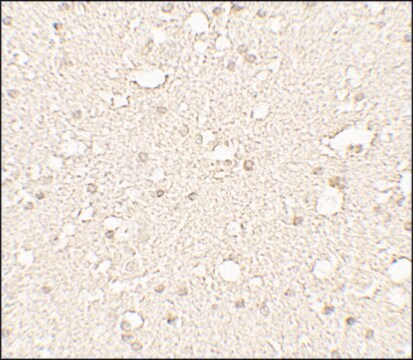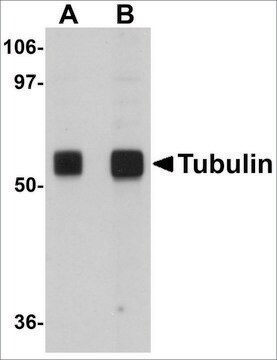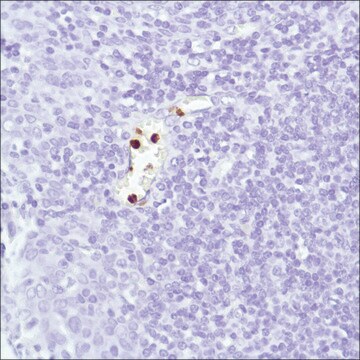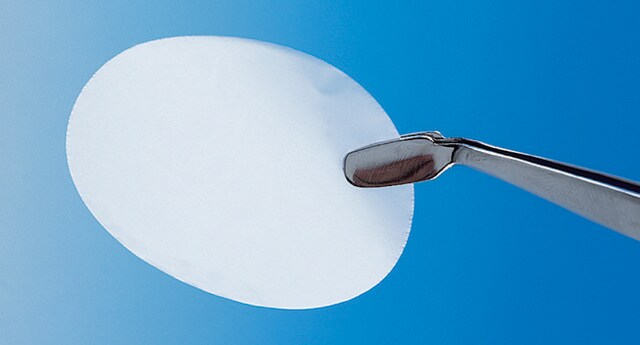CBL270-I
Anti-alpha-Tubulin Antibody, clone YOL1/34
clone YOL1/34, from rat
Synonym(e):
Tubulin alpha-1 chain, alpha-tubulin
About This Item
Empfohlene Produkte
Biologische Quelle
rat
Qualitätsniveau
Antikörperform
purified immunoglobulin
Antikörper-Produkttyp
primary antibodies
Klon
YOL1/34, monoclonal
Speziesreaktivität
rat, mouse, human, yeast, amoeba, porcine
Methode(n)
ELISA: suitable
affinity binding assay: suitable
electron microscopy: suitable
immunocytochemistry: suitable
western blot: suitable
Isotyp
IgG2aκ
NCBI-Hinterlegungsnummer
UniProt-Hinterlegungsnummer
Versandbedingung
ambient
Posttranslationale Modifikation Target
unmodified
Angaben zum Gen
Saccharomyces cerevisiae ... Tub1(854889)
human ... TUBA1A(7846)
Allgemeine Beschreibung
Spezifität
Immunogen
Anwendung
Western Blotting Analysis: 1 µg/mL from a representative lot detected alpha-tubulin in 10 µg of NIH/3T3 mouse fibroblast and PC12 rat pheochromocytoma cell lysates.
Affinity Binding Assay: Pig brain α-tubulin, α-tubulin/β-tubulin heterodimer, as well as α-tubulin proteolytic fragments a.a. 414-425 and a.a. 403-422, but not β-tubulin or actin, effectively competed against immobilized α-tubulin for YOL 1/34 binding (Breitling, F., and Little, M. (1986). J. Biol. Chem. 189(2):367-370).
Electron Microscopy Analysis: A representative lot immunostained microtubules of crude yeast nuclear envelope preparation (Kilmartin, J.V., et al. (1982). J. Cell Biol. 93(3):576-582).
ELISA Analysis: A representative lot detected pig brain α-tubulin by direct (non-sandwich) ELISA (Breitling, F., and Little, M. (1986). J. Biol. Chem. 189(2):367-370).
Immunocytochemistry Analysis: A representative lot immunostained fixed NIH/3T3 cells as well as yeast spheroplasts and nuclei preparations (Kilmartin, J.V., et al. (1982). J. Cell Biol. 93(3):576-582).
Immunocytochemistry Analysis: A representative lot immunostained microtubules of fixed Dictyostelium (amoeba) as well as isolated and stabilized amoeba cytoskeleton (Kilmartin, J.V., et al. (1982). J. Cell Biol. 93(3):576-582).
Western Blotting Analysis: A representative lot detected α-tubulin in spermatozoa sample from from fertile and infertile men (Breitling, F., et al. (1991). Gene. 104(2):147-153).
Qualität
Western Blotting Analysis: 1 µg/mL of this antibody detected alpha-tubulin in 10 µg of HeLa cell lysate.
Zielbeschreibung
Verlinkung
Physikalische Form
Sonstige Hinweise
Sie haben nicht das passende Produkt gefunden?
Probieren Sie unser Produkt-Auswahlhilfe. aus.
Lagerklassenschlüssel
12 - Non Combustible Liquids
WGK
WGK 1
Flammpunkt (°F)
Not applicable
Flammpunkt (°C)
Not applicable
Analysenzertifikate (COA)
Suchen Sie nach Analysenzertifikate (COA), indem Sie die Lot-/Chargennummer des Produkts eingeben. Lot- und Chargennummern sind auf dem Produktetikett hinter den Wörtern ‘Lot’ oder ‘Batch’ (Lot oder Charge) zu finden.
Besitzen Sie dieses Produkt bereits?
In der Dokumentenbibliothek finden Sie die Dokumentation zu den Produkten, die Sie kürzlich erworben haben.
Unser Team von Wissenschaftlern verfügt über Erfahrung in allen Forschungsbereichen einschließlich Life Science, Materialwissenschaften, chemischer Synthese, Chromatographie, Analytik und vielen mehr..
Setzen Sie sich mit dem technischen Dienst in Verbindung.








